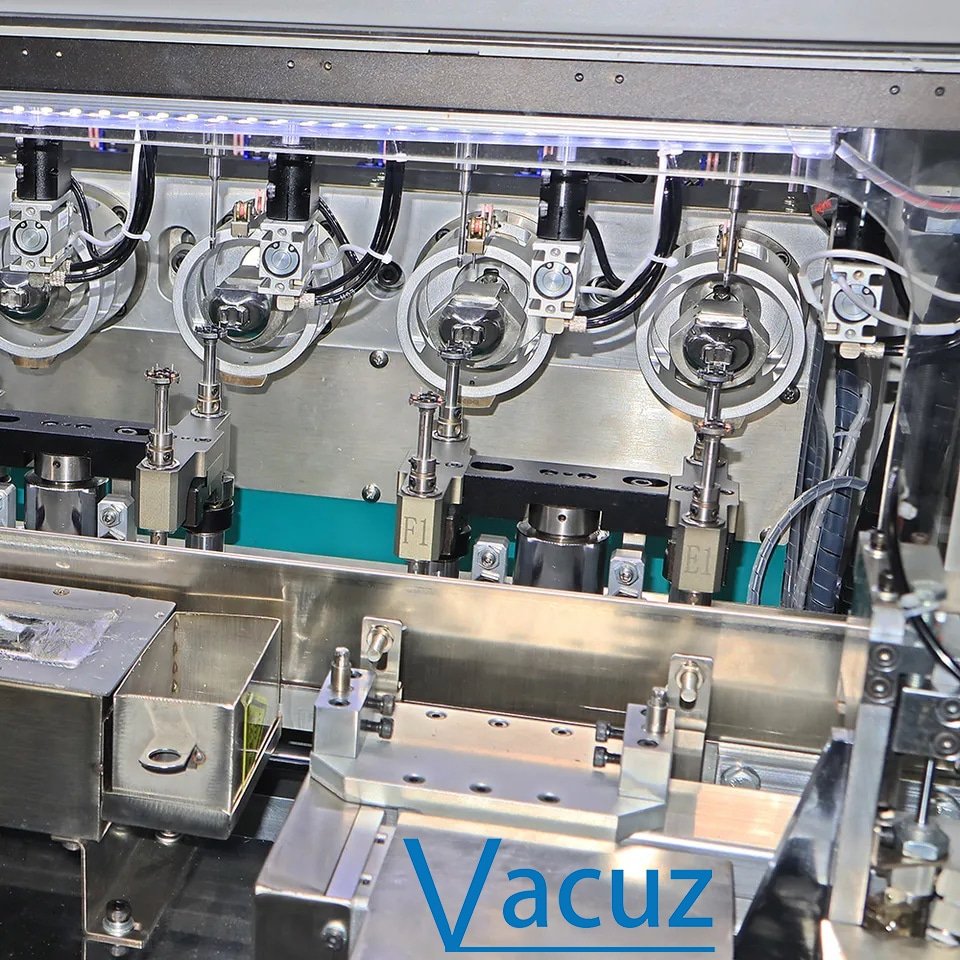When discussing the fully automated production of motor stator winding machines, we do need to conduct a detailed analysis from multiple dimensions such as equipment configuration, process design, control system, auxiliary functions, key technical indicators, and application cases. The following is a detailed explanation of these aspects by Vacuz, I hope it can help everyone!

Зовнішній статор Вібраційна пластина подачі Vacuz Повністю автоматичний безщітковий безпілотник BLDC безпілотник БПЛА Вентилятор охолодження Котушка двигуна Літаюча вилка Обмотувальна машина Виробник
1. Equipment configuration requirements
1. High-precision winding mechanism : A precision winding head driven by a servo motor and equipped with a tension control system to ensure stable winding of the wire. The wire diameter adapts to a wide range, and wires from 0.02mm to 1.2mm can be stably wound. In addition, the configuration of a multi-station structure (such as double-station, four-station, and six-station) supports multi-wire parallel winding to improve production efficiency.
2. Automated loading and unloading system : Integrated robotic arms or special fixtures to achieve automatic grasping, positioning and clamping of the stator core, and seamless docking with the logistics line. Visual recognition technology is used to ensure accurate positioning of the stator core, with a positioning accuracy of up to ±0.02mm.
3. Intelligent detection system: Equipped with coil turns detection, wire diameter detection, insulation performance detection and other modules to monitor the winding quality in real time. Introduce machine vision technology to detect appearance defects of the stator after winding, such as broken wires, jumpers, abnormal turns, etc.
4. Efficient wire arrangement and cutting mechanism: Adopt servo-driven wire arrangement mechanism to ensure that the wires are arranged neatly to avoid crossing or overlapping. Configure automatic wire cutting device to support automatic cutting and processing of wire ends after winding.
II. Process design requirements
1. Winding process parameterization: Support flexible setting of parameters such as coil turns, winding speed, winding tension, etc. to meet the winding requirements of stators of different specifications. Equipped with a process database, it can store winding process parameters of various stators to achieve rapid changeover.
2. Mold and fixture design: Design special winding molds for different stator models to ensure the shape and size accuracy of the coil. The fixture must have a quick replacement function to reduce the changeover time.
3. Wire processing technology: Integrate pre-treatment functions such as wire preheating, coating, and drying to improve the insulation performance and winding quality of wires. Support special process requirements such as multi-strand winding.
III. Control system requirements
1. Industrial-grade PLC and motion control: Use high-performance PLC, combined with multi-axis motion controller, to achieve coordinated control of winding mechanism, wire arrangement mechanism, and loading and unloading system. Support industrial bus protocol to ensure high real-time and stability of the system.
2. Human-machine interaction interface: Equipped with touch screen operation terminal, support intuitive setting and monitoring of process parameters. Provide production data statistics and analysis functions, such as yield rate, production efficiency, etc.
3. Remote monitoring and maintenance: Support remote monitoring and fault diagnosis of equipment through industrial Ethernet or 4G/5G network. Integrate predictive maintenance function to warn equipment failure in advance through data analysis.
IV. Auxiliary function requirements
1. Safety protection design: Equipped with safety gratings, emergency stop buttons and other safety devices, in compliance with international safety standards such as CE and UL. Adopt closed protective cover to prevent foreign matter from entering the equipment.
2. Environmental adaptability: The equipment must have dustproof and anti-static functions to adapt to the environmental requirements of the motor production workshop. Support real-time monitoring and adjustment of environmental parameters such as temperature and humidity.
3. Modularity and scalability: Adopt modular design to facilitate equipment upgrade and maintenance. Reserve interface to support future function expansion (such as automatic encapsulation, varnishing, etc.).
V. Key technical indicators
1. Winding accuracy: Coil turn error ≤±1 turn, wire diameter deviation ≤±0.01mm.
2. Production efficiency: Single-station winding speed can reach 1000-3000 rpm, and multi-station equipment efficiency is increased by 3-5 times.
4. Equipment stability: MTBF (mean time between failures) ≥5000 hours.
5. Changeover time: ≤15 minutes (including mold replacement and process parameter adjustment).

Зовнішній статор Вібраційна пластина подачі Vacuz Повністю автоматичний безщітковий безпілотник BLDC безпілотник БПЛА Вентилятор охолодження Котушка двигуна Літаюча вилка Обмотувальна машина Виробник
In summary, through the above configuration and design, the motor stator winding machine can realize the full process automated production from stator core loading to finished product off-line, significantly improving production efficiency and product quality, while reducing labor costs and defective rates.
Електронна пошта: sales@vacuz.com





